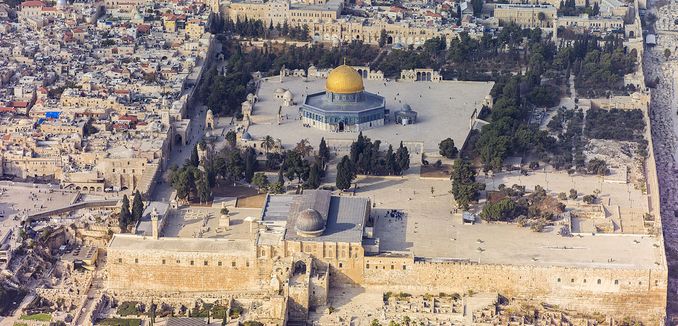Artifacts including tiny shards of clay and bone from the time of Solomon’s Temple were unearthed for the first time on the Temple Mount, Israeli archaeologists revealed on Thursday.
The discoveries, which include “olive pits, animal bones and pottery fragments dating to the time of the First Temple, between the 8th and 6th Centuries BCE,” were made during a series of low-profile excavations on the Temple Mount over the past decade, The Times of Israel reported. The digs were the first to be approved since the time of the British Mandate, and marked the first time that archaeologists found artifacts from the First Temple period in situ on the Temple Mount.
The excavations were carried out with the cooperation of the Islamic Waqf, the Muslim authority that administers the Temple Mount, and their findings were presented at a Hebrew University conference.
Similar artifacts from the First Temple period have previously been found at nearby sites, including by the Temple Mount Sifting Project, which goes through some 400 truckloads topsoil that the Islamic Waqf dug and removed from the Temple Mount in 1999. The rubble, which has been found to contain artifacts from the First and Second Temple periods, was dumped by the Muslim authority in a landfill at Jerusalem’s Kidron Valley under the cover of night.
“It’s the first time that we’ve found artifacts from this period in situ on the Temple Mount,” the head of the Israel Antiquities Authority Jerusalem region, Yuval Baruch, explained of the recent finds. “As far as the biblical period is concerned, the Temple Mount is a tabula rasa, nobody knows anything,” added Baruch, who supervised the excavations. He noted that while the discoveries are still “very limited,” they further demonstrate that Jewish history “exists” in the Temple Mount.
The excavations began after the Waqf sought permission from Israeli authorities to improve the infrastructure around the al-Aqsa Mosque and Dome of the Rock in 2007. Similar work had been carried out by the Waqf previously, including during the construction of the Marwani Mosque in the late 1990s, which took place without archaeological supervision and resulted “in the destruction of antiquities and severe tensions between Israel and the Islamic authorities.”
In 2007, the Waqf used a tractor to dig a 4-foot-deep trench on the northern end of the Temple Mount, which they said was necessary to replace old electric cables. At the time, archaeologist Zachi Zweig said, “there is a high probability that ancient remnants were damaged,” among them the foundation of a wall that could have belonged to the Second Temple. However, that incident also “allowed archaeologists the first opportunity to delve below the surface of the contested holy site since Israel captured it in the 1967 Six Day War,” the Times reported. This work was carried out with police escorts because of the potential for trouble.
“The finds on the Temple Mount itself range from a previously undocumented monumental structure believed to be from the 11th and 12th centuries — the period preceding and including the Crusades — to artifacts from Roman times,” in addition to the artifacts from the First Temple era, the Times noted.
Baruch, Ronny Reich, and Deborah Sandhaus, who together authored a report on the discoveries, said that the biggest find of the First Temple relics occurred while installing an electric cable some 400 feet southeast of the Dome of the Rock. “This layer included pottery fragments characterized in the 8th and 7th centuries BCE, as well as animal bones and charred olive pits,” they observed. “Carbon 14 dating of the olives yielded dates from the 6th to 8th centuries BCE. This date is confirmed by the dates of the pottery.”
In another part of the same area, Roman coins were found from 383 CE, as well as iron arrowheads. The archaeologists speculated that these were signs “of activity in the Roman period in the courtyard between the raised part of the Temple Mount and the Al-Aqsa Mosque.”
Nearby, at the Church of the Holy Sepulchre, conservationists have unearthed the limestone bed said to be the one upon which Jesus was initially laid to rest, The Times of Israel reported Monday. The recent discovery of what is believed to be the tomb of Jesus reinforces the historical ties of both Jews and Christians to Jerusalem.
These discoveries mark the third and fourth major archaeological developments announced in recent weeks, which coincide with and contradict two recent Arab-drafted UNESCO resolutions denying the extent of Jewish and Christian historical links to Jerusalem, particularly the Temple Mount.
Previously, the Israel Antiquities Authority (IAA) announced that it had found the oldest Hebrew-language mention of Jerusalem yet discovered, dating back some 2,700 years to the time of the First Jewish Temple. That came a week after the IAA announced that it located the place where Roman troops breached the walls of Jerusalem during their siege of the city and eventual destruction of the Second Jewish Temple nearly 2,000 years ago.
Eylon Aslan-Levy explained in The Tower on Monday that UNESCO’s resolutions, which were “a bid by dictatorships (with the acquiescence of democracies) to render Israeli sovereignty over the Old City utterly illegitimate, do the most damage by prejudging how the international community should approach the question of the holy sites in any future accord.”
[Photo: Andrew Shiva / WikiCommons ]




